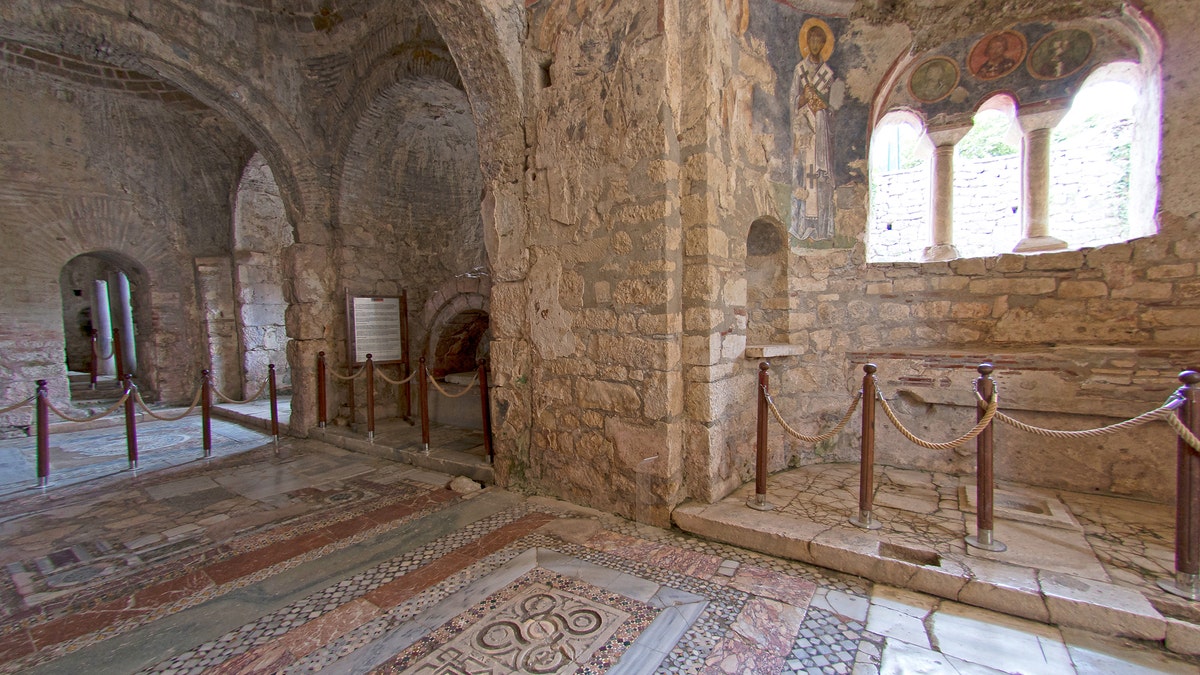Fox News Flash top headlines for October 19
Fox News Flash top headlines are here. Check out what's clicking on Foxnews.com.
Turkish archeologists believe they have confirmed the original resting place of St. Nicholas, the inspiration for Santa Claus and victim of grave theft in the 11th century.
"This is an extremely important discovery, the first find from that period," said Osman Eravsar, chairman of the Antalya Cultural Heritage Preservation Regional Board.
Fox News Digital in 2017 reported that a team of researchers had started an examination of St. Nicholas Church in Demre, a roughly 7th century church, using CT-scanning technology and geo-radars to examine a tomb beneath the foundations.
The final resting place of St. Nicholas, a 4th century Greek bishop who inspired the legend of Santa Claus, was well known after a group of wealthy Italian men in 1087 A.D. decided to take the body, breaking open the saint’s original resting place to retrieve him.
MISSISSIPPI RIVER'S LOW WATER LEVEL REVEALS SHIPWRECK

This file photo shows the interior of St. Nicholas Church in Demre, Turkey. Experts believe that the grave of St. Nicholas, the historical inspiration for Santa Claus, may be beneath the church. (Kenan Olgun/iStock)
The original resting place remained unknown until the end of the 20th century, when researchers started examining the foundations of the Church of St. Nicholas in Demre, a southern Turkish city, and found an older church beneath the current one.
"When the screed floor slab laid in the 1970s was removed where it was, an excavation was carried out to find out what's under it," Eravsar told Turkish outlet DHA. "The result was an early 4th century floor covering of the church. The current church is later dated."
ANDES PLANE CRASH SURVIVORS RECOUNT RESORTING TO CANNIBALISM 50 YEARS LATER
"There are some architectural traces in various parts of the early period structure, but there were no traces in terms of flooring. This is an emerging, perhaps earlier, flooring," he added.

St. Nicholas of Myra was a Christian bishop of the ancient city of Demre, Turkey, during the Roman Empire (iStock)
Researchers found a fresco of Jesus under the new flooring, and the combination of Jesus making the sign of blessing, as well as a tile bearing the Greek words for "as grace," indicate that St. Nicholas originally lay beneath the fresco.
Researchers had difficulty examining the foundation, which had sand and silt obscuring much of the original church floor, which originated in the 3rd or 4th century. The current church was built in the 7th or 8th century.

St. Nicholas Church is a former Byzantine church in today's Turkish city of Demre in the province of Antalya. It was used from the 5th to the 12th century. It is best known as the first burial place of St. Nicholas of Myra. (Schellhorn/ullstein bild via Getty Images)
St. Nicholas was born in Patara, an ancient city in Lycia on the southwestern coast of Turkey. Nicholas went to Myra, which later became known as Demre, and served as bishop for many years. He reportedly would give away his inherited wealth anonymously to the poor, inspiring the tales of Santa Claus.
Eravsar claimed the discovery would "increase the architectural history" of the area, and that researchers will cover the display after using a "certain technique" to protect it following the completion of the research.
The most exciting element of the discovery was the finding of additional relics belonging to St. Nicholas, though their condition may not be ideal. The church sits below sea level, leaving it prone to occasional flooding.
CLICK HERE TO GET THE FOX NEWS APP
"Because geophysical studies have some distractors, one of them is the humidity in the field. If there is intense moisture and water, no results can be obtained," Eravsar explained. "In that case, the only thing we can do left is to excavate that area.
"If these are done by the excavation heads in the future, this information will come out more concretely, and we will learn new things."

